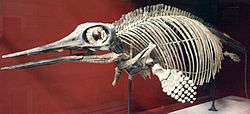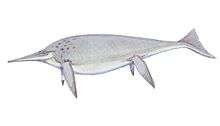Ophthalmosauridae
Ophthalmosauridae is an extinct family of thunnosaur ichthyosaurs from the Middle Jurassic to the early Late Cretaceous (Bajocian - Cenomanian) of Asia, Australia, Europe, North America and South America.[1] Currently, the oldest known ophthalmosaurid is Mollesaurus from the early Bajocian of Argentina.[2] Named by George H. Baur, in 1887, it contains the basal taxa like Ophthalmosaurus.[1] Appleby (1956) named the taxon Ophthalmosauria which was followed by some authors,[3][4] but these two names are synonyms, Ophthalmosauridae has the priority over Ophthalmosauria.[1]
| Ophthalmosaurids | |
|---|---|
 | |
| Ophthalmosaurus icenicus skeleton | |
| Scientific classification | |
| Kingdom: | Animalia |
| Phylum: | Chordata |
| Class: | Reptilia |
| Order: | †Ichthyosauria |
| Clade: | †Baracromia |
| Family: | †Ophthalmosauridae Baur, 1887 |
| Subgroups | |
| Synonyms | |
| |
Phylogeny

Ophthalmosauridae is a node-based taxon defined by Ryosuke Motani (1999) as "the last common ancestor of Brachypterygius extremus and Ophthalmosaurus icenicus and all of its descendants". The definition he proposed for Ophthalmosauria was exactly the same.[3] In this case both definitions are synonyms. The cladogram below follows the topology from a 2010 analysis by Patrick S. Druckenmiller and Erin E. Maxwell.[4]
| Thunnosauria |
| ||||||||||||||||||||||||||||||||||||||||||||||||||||||||||||||||||||||||
Valentin Fischer, Edwige Masure, Maxim S. Arkhangelsky and Pascal Godefroit (2011) described a new genus of Ophthalmosauridae. They redefined it as "the last common ancestor of Arthropterygius chrisorum and Ophthalmosaurus icenicus and all of its descendants". In this case Ophthalmosauria isn't a junior synonym of Ophthalmosauridae. The cladogram below follows Fischer et al. 2011.[1]
| Thunnosauria |
| |||||||||||||||||||||||||||||||||||||||||||||||||||||||||||||||||||||||||||
*Note: Placement of Ophthalmosauria by definition.
Fischer et al. (2012) described another new genus of Ophthalmosauridae. They defined for the first time two subfamilies within the Ophthalmosauridae, Ophthalmosaurinae and Platypterygiinae. Ophthalmosaurus and Platypterygius were found to be non-monophyletic. Ophthalmosauridae was characterized by a reduced extracondylar area, a plate-like dorsal trochanter, a humerus with a facet for an anterior accessory element and the absence of notching on the paddle elements of the forefin. The cladogram below follows Fischer et al. 2012.[6]
| Thunnosauria |
| ||||||||||||||||||||||||||||||||||||||||||||||||||||||||||||||||||||||||||||||||||||||||||
References
- Fischer, V.; Masure, E.; Arkhangelsky, M.S.; Godefroit, P. (2011). "A new Barremian (Early Cretaceous) ichthyosaur from western Russia". Journal of Vertebrate Paleontology. 31 (5): 1010–1025. doi:10.1080/02724634.2011.595464.
- Marta S. Fernández (1999). "A new ichthyosaur from the Los Molles Formation (Early Bajocian), Neuquen Basin, Argentina". Journal of Paleontology. 73 (4): 677–681. doi:10.1017/S0022336000032492. JSTOR 1306766.CS1 maint: uses authors parameter (link)
- Ryosuke Motani (1999). "Phylogeny of the Ichthyopterygia" (PDF). Journal of Vertebrate Paleontology. 19 (3): 472–495. doi:10.1080/02724634.1999.10011160. Archived from the original (PDF) on 2016-03-05. Retrieved 2011-10-19.CS1 maint: uses authors parameter (link)
- Patrick S. Druckenmiller and Erin E. Maxwell (2010). "A new Lower Cretaceous (lower Albian) ichthyosaur genus from the Clearwater Formation, Alberta, Canada". Canadian Journal of Earth Sciences. 47 (8): 1037–1053. Bibcode:2010CaJES..47.1037D. doi:10.1139/E10-028.CS1 maint: uses authors parameter (link)
- Arkhangel’sky, M. S., 1998, On the Ichthyosaurian Genus Platypterygius: Palaeontological Journal, v. 32, n. 6, p. 611-615.
- Valentin Fischer; Michael W. Maisch; Darren Naish; Ralf Kosma; Jeff Liston; Ulrich Joger; Fritz J. Krüger; Judith Pardo Pérez; Jessica Tainsh; Robert M. Appleby (2012). "New Ophthalmosaurid Ichthyosaurs from the European Lower Cretaceous Demonstrate Extensive Ichthyosaur Survival across the Jurassic–Cretaceous Boundary". PLoS ONE. 7 (1): e29234. Bibcode:2012PLoSO...729234F. doi:10.1371/journal.pone.0029234. PMC 3250416. PMID 22235274.
